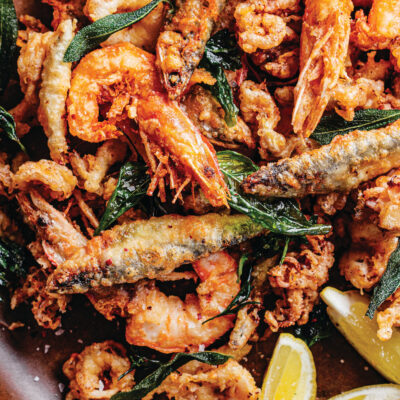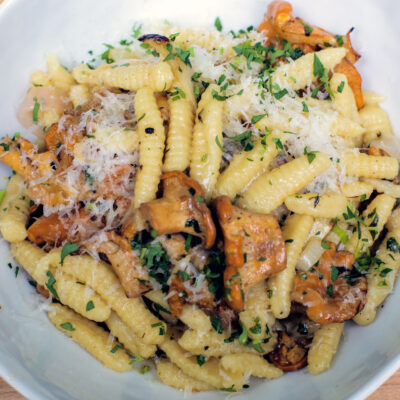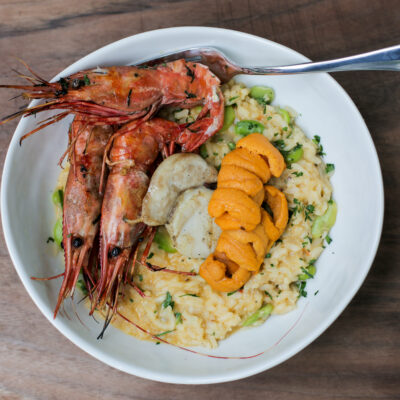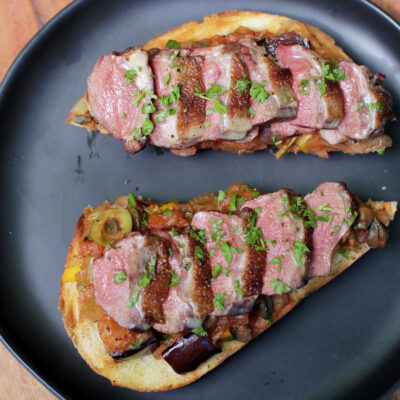Garganelli with Prosciutto & Peas
Especially if you swap out store-bought penne for the garganelli, this recipe can come together in a matter of minutes. In the restaurant, I like to add in arugula at the end of cooking so that it wilts in the pan, and then garnish the finished plate with arugula flowers for an added dimension and a little spiciness. But really, it’s the kind of dish that shouldn’t be tweaked too much, because it’s so straightforward. Just let it float. For that same reason, buy the best ingredients you can for this dish, because simplicity often exposes the quality of your ingredients, for better and worse.
Recipe from Flour + Water: Pasta by Thomas McNaughton.
Garganelli with Prosciutto & Peas
Ingredients
Equipment
- Pasta machine + Baking sheets + Straight wheel cutter (optional)
- Garganelli comb or gnocchi board + Dowel + Blender
Store-bought option
- Dried penne or ziti
Garganelli
- 1 recipe Standard Egg Dough
- Pea Puree
- 5 ounces English peas (130 grams)
- 1/2 cup pea shoots (55 grams)
- 1 tablespoon whole milk
- About 1/4 cup water
- Kosher salt
To Finish
- 2 tablespoons pure olive oil
- 3 ounces diced prosciutto (85 grams)
- 1 tablespoon minced green garlic, or 1½ teaspoons minced garlic
- 1 1/2 ounces spring onions, diced into 1/8-inch pieces
- 1 1/2 cups chicken stock
- 5 1/2 ounces shelled English peas (156 grams)
- 4 tablespoons butter, chilled (57 grams)
- 3 cups baby arugula (50 grams)
- Juice of 1/2 lemon
- Kosher salt
- Freshly ground black pepper
- Freshly grated Parmigiano-Reggiano, for finishing
- 20 arugula flowers, stemmed, for garnish (optional)
Standard Egg Dough
- Makes 644 grams/22.7 ounces of dough
- 360 grams 00 flour (2 well-packed cups, unsifted)
- 1 1/4 teaspoons (2 big pinches) kosher salt
- 300 grams egg yolks (1¼ cups/18 to 20 yolks)
- 1 1/2 teaspoons extra-virgin olive
Instructions
To make the pasta, follow the instructions for the Egg Dough below.
Dust 2 baking sheets with semolina flour and set aside. Using a pasta machine, roll out the dough to 1/16 inch thick.
Cut a 2-foot section of the pasta sheet and cover the rest of the dough with plastic wrap. With a sharp knife or straight wheel cutter, cut the pasta dough into 2-inch squares. Place one square on the garganelli comb, positioned diagonally, so two corners are at the top and bottom.
Place the dowel on the bottom of the comb. Using your fingers if necessary, curl up the corner so it curls up around the dowel to help get the tube started. In one smooth but firm motion, roll the dowel away from you from the bottom corner to the top corner, forming the tube-like garganelli.
Place the garganelli on the prepared baking sheet, uncovered, to air dry at room temperature until ready to cook. Repeat with the remaining dough. Have ready a bowl of ice water.
To make the puree, cook the peas and shoots in boiling salted water until tender, about 2 minutes. Transfer to the ice bath and cool completely, about 2 minutes. Remove the peas from the water and store, refrigerated, until ready to use.
Put the peas and shoots in the jar of a blender. Add the milk and begin to puree. Add just enough water, roughly 1/4 cup, to achieve a smooth puree. Season with salt. You should have about 2 cups (475 milliliters).
To finish, bring a large pot of seasoned water to a boil.
Heat a 12-inch sauté pan over medium heat until hot but not smoking. Add the olive oil and heat until it gently ripples on the surface of the pan. Add the prosciutto. It should sizzle the moment it hits the pan. You want to brown it a bit without making it crispy, about 1 minute. This step will infuse the oil with the prosciutto flavor, which will permeate the entire dish.
Add the green garlic and spring onions and cook, stirring occasionally, until the vegetables are translucent, about
5 minutes. You want to keep stirring to prevent the garlic from burning.
Add the chicken stock, bring to a boil over medium heat, and allow the stock to begin to reduce. If using homemade garganelli, you want the stock to begin boiling in the pan before you drop the pasta in the water. If using store-bought dried penne you should add the pasta to the water when you begin cooking the prosciutto.
Increase the heat under the sauté pan to medium-high and bring the liquid to a boil. Cook about 1 minute. Add the
peas to warm through. Once the pasta is cooked 80 percent through, until almost al dente, about 2 to 3 minutes if using homemade gargamelli, add it to the pan. Cook in the pan for about 2 minutes. Add the butter and the pea puree and vigorously swirl the pan to create an emulsion. We want to keep reducing until the sauce coats the noodle.
Turn off the heat and gently fold in the arugula. Toss the pasta to incorporate the arugula. Add the lemon juice and season with salt and freshly ground black pepper.
To serve, divide the pasta and sauce between four plates. Garnish with grated Parmigiano-Reggiano, sprinkle with arugula flowers, if using, and serve immediately.
Standard Egg Dough
Step One: Mixing
To start, place the flour on a dry, clean work surface, forming a mound about 8 to 10 inches in diameter at its base. Sprinkle the salt in the middle of the mound. Using the bottom of a measuring cup, create a well 4 to 5 inches wide, with at least a half inch of flour on the bottom of the well.
Slowly and carefully add the wet ingredients (eggs and olive oil) into the well, treating the flour as a bowl. Using a fork, gently beat the eggs without touching the flour walls or scraping through the bottom to the work surface.
Then, still stirring, begin to slowly incorporate the flour “walls” into the egg mixture, gradually working your way toward the outer edges of the flour, but disturbing the base as little as possible. If the eggs breach the sides too soon, quickly scoop them back in and reform the wall. Once the dough starts to take on a thickened, paste-like quality (slurry), slowly incorporate the flour on the bottom into the mixture.
When the slurry starts to move as a solid mass, remove as much as possible from the fork. Slide a bench scraper or spatula under the mass of dough and flip it and turn it onto itself to clear any wet dough from the work surface.
At this point, with your hands, start folding and forming the dough into a single mass. The goal is to incorporate all the flour into the mass, and using a spray bottle to liberally spritz the dough with water is essential. It is a very dry dough, and it cannot be overstated how important it is to generously and constantly spritz to help “glue” any loose flour to the dry dough ball.
When the dough forms a stiff, solid mass, scrape away any dried clumps of flour from the work surface, which, if incorporated in the dough, will create dry spots in the final product.
Step Two: Kneading
Kneading is an essential step in the dough-making process: it realigns the protein structure of the dough so that it develops properly during the resting stage that follows.
Kneading is simple: Drive the heel of your dominant hand into the dough. Push down and release, and then use your other hand to pick up and rotate the dough on itself 45 degrees.
Drive the heel of your hand back in the dough, rotate, and repeat for 10 to 15 minutes. This is how Italian grandmas get their fat wrists.
Pasta is easy to underknead but virtually impossible to overknead (unlike bread, where each type has its sweet spot or ideal kneading time). That said, even though the dough cannot be overkneaded, it can spend too much time on the worktable—and, as a direct result, start to dehydrate and be more difficult to form into its final shape. For best results, I think a 10 to 15 minute range is a solid guideline. When the dough is ready, it will stop changing appearance and texture. The dough will be firm but bouncy to the touch and have a smooth, silky surface, almost like Play-Doh. Tightly wrap the dough in plastic wrap.








